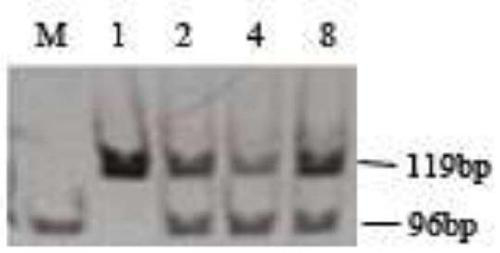Method of performing gene correction on hemopoietic stem cells of patient with Mediterranean anemia
A hematopoietic stem cell and gene technology, applied in the field of genetic engineering, can solve other problems such as gene damage and off-target effects, and achieve the effects of improving efficiency, simple operation, and convenient gene editing
- Summary
- Abstract
- Description
- Claims
- Application Information
AI Technical Summary
Problems solved by technology
Method used
Image
Examples
Embodiment Construction
[0048] The present invention will be specifically introduced below in conjunction with the accompanying drawings and specific embodiments.
[0049] A method for genetically correcting hematopoietic stem cells of a thalassemia patient, comprising the steps of:
[0050] Step 1, select the CRISPR target near the HBB gene-28 (A / G) site, and design the gRNA sequence;
[0051] For the -28(A / G) site, 3 gRNA sequences were designed on the HBB gene, each gRNA contains 20bp, followed by a PAM sequence; the specific sequence of the gRNA is as follows:
[0052] gRNA1: GGAGGGCAGGAGCCAGGGCT GGG;
[0053] gRNA2:CCAATCTACTCCCAGGAGCAGGG;
[0054] gRNA3: AGGGCTGGGCATAAAAGTCAGGG.
[0055] It should be noted that: target requirements:
[0056] The target point is within the range of 10 bp before and after the mutation site -28 (A / G), which ensures the efficiency of homologous recombination after cleavage.
[0057] gRNA sequence requirements:
[0058] 20 nucleotide sequence length;
[0059]...
PUM
 Login to View More
Login to View More Abstract
Description
Claims
Application Information
 Login to View More
Login to View More - R&D
- Intellectual Property
- Life Sciences
- Materials
- Tech Scout
- Unparalleled Data Quality
- Higher Quality Content
- 60% Fewer Hallucinations
Browse by: Latest US Patents, China's latest patents, Technical Efficacy Thesaurus, Application Domain, Technology Topic, Popular Technical Reports.
© 2025 PatSnap. All rights reserved.Legal|Privacy policy|Modern Slavery Act Transparency Statement|Sitemap|About US| Contact US: help@patsnap.com



